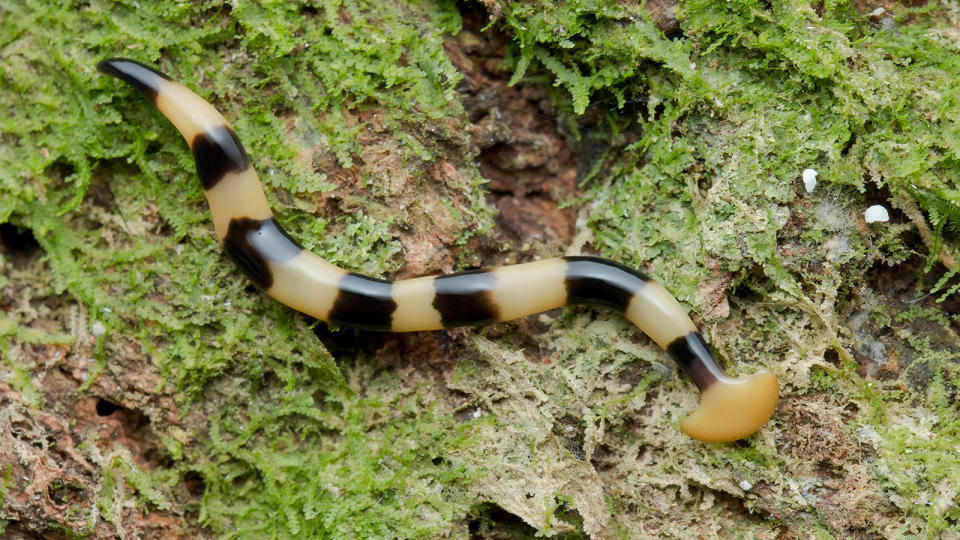Hammerhead Worms Are Toxic, Invasive and Even Cannibalistic
Every now and again, Americans get word that a new killer invertebrate is invading our country: killer bees, murder hornets, fire ants, the list goes on and on. It keeps the news spicy.
Hammerhead flatworms — commonly called hammerhead worms — occasionally make headlines because they aren't native to many regions and are toxic, aggressive predators. Their slimy, leech-like bodies with anvil-shaped heads, resembling a hammerhead shark, add to their menacing reputation.
What Are Hammerhead Worms?
Hammerhead worms are an invasive species of terrestrial flatworm from the genus Bipalium. They can grow up to 18 inches (46 centimeters) long, sometimes leading people to mistake them for snakes.
Native to tropical regions, such as Southeast Asia, these terrestrial planarians prey on small animals, using enzymes to digest their prey externally before consuming them. While they pose little danger to humans, their presence can significantly impact local ecosystems by reducing earthworm populations, which are essential for soil health.
Due to the invasive nature of this shovel-headed garden worm, the Texas Invasive Species Institute monitors the non-native species to better understand its environmental impact.
Slimy Invaders
Hammerhead worms are not new to the U.S. or many other parts of the world. They've been common residents of American gardens since the early 1900s. These predatory planarians thrive in tropical and subtropical regions but have spread globally through commerce over the past couple of centuries.
While they can adapt to various habitats, you're unlikely to find them in deserts or high-altitude regions.
"The majority of land flatworms in the U.S. are not native," says Matt Bertone, an entomologist at NC State University, of the invasive species. "However, some have been here for over 100 years, so they are well established. They easily hide among objects and in soil where there's moisture, so moving any type of container or plants around the world has allowed them to colonize new areas. Thus, they are highly invasive and frequently show up in new regions."
Powerful Predators
Hammerhead worms are carnivorous and often even cannibalistic. They are sensitive to light and are active mostly at night, feeding on a variety of small, soft-bodied animals like snail species, slugs and earthworms, although they occasionally feed on other small invertebrates like insects.

"They wrap around their prey with sticky mucus, and use a mouth located on their belly in the middle of the body to consume prey," says Bertone. "They use special enzymes to digest the prey outside of their body."
After digesting their prey into a gooey puddle, the hammerhead worm uses tiny, hairlike structures on its underside, called cilia, to suck in the victim. These cilia also aid in locomotion, acting like microscopic legs that pull the land planarian along a slimy film it secretes.
Complex Reproduction
The lifecycles of flatworms are complex and differ from species to species. Hammerhead worms are hermaphroditic — meaning they have both male and female reproductive organs — and can reproduce either sexually or asexually, with asexual reproduction being more common.
For instance, Bipalium kewense Moseley, a species native to Southeast Asia but now widespread, reproduces by fission, especially when outside its native range. In this process, a small portion of the body near the tail pinches off and becomes a new worm, a clone of its parent.
In other species, the worms produce eggs when they mate with other worms, self-fertilize or clone themselves. As part of ecological observations, researchers have documented this process of rare egg capsule production.
Are Hammerhead Worms Dangerous?
"Species of Bipalium are the only known terrestrial invertebrates that produce tetrodotoxin, the poison that makes puffer fish deadly," Bertone says. "However, they do so only in small amounts and are not dangerous to humans unless eaten in large numbers. Thus, their danger is often over-exaggerated."
On the other hand, this land planarian does pose a real threat to earthworm populations. In France, researchers are concerned about the hammerhead worm populations that somehow went undetected for more than 20 years.
The concern is that this shovel-headed garden worm — which doesn't aerate and fertilize the soil as earthworms do — has been eating earthworms and other helpful soil fauna into scarcity.
Eradicating Hammerhead Worms
As an invasive species, the hammerhead flatworm can wreak havoc on your garden. To kill hammerhead worms, avoid simply cutting them, as they can regenerate into new worms from fragments. Instead, use methods that will ensure the animal is completely destroyed.
One effective approach is to sprinkle salt or citrus oil directly on the worms, which dehydrates and kills them. Another method is to place them in a sealed plastic bag and freeze them for at least 48 hours. Applying vinegar or spraying them with a mixture of soapy water can also work.
Handling flatworms, especially invasive hammerhead worms, requires care. Wear gloves when handling a hammerhead species and always wash your hands thoroughly afterward to avoid skin irritation from prolonged exposure to their slime.
We updated this article in conjunction with AI technology, then made sure it was fact-checked and edited by a HowStuffWorks editor.
Original article: Hammerhead Worms Are Toxic, Invasive and Even Cannibalistic
Copyright © 2024 HowStuffWorks, a division of InfoSpace Holdings, LLC, a System1 Company


